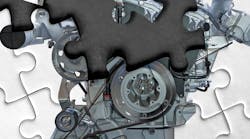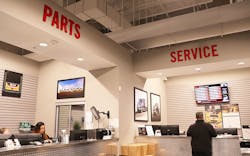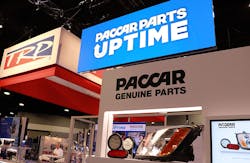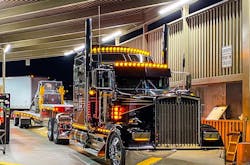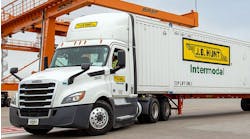This is the first of a three-part series on the changing aftermarket landscape and how to best source parts. Read Part 2 and Part 3.
Most fleets can’t compete when their assets are broken down and parked in a holding bay waiting for the right part to arrive.
“It is just astronomical, the hassle it is, when a truck goes out of service for more than a day or two,” said Brian Kurtt, Navistar’s fleet service representative for Summit Truck Group, a leading International Truck dealer.
When a truck isn’t earning, a fleet is losing on average $800 a day, though the downtime could be costing much more: customers and drivers.
The desire to increase uptime is obvious, but what isn’t always understood is how to configure your parts network to optimize that uptime, and to ensure during normal operations and in emergencies the parts you need to get to where they must go.
That’s easier said than done. Those parts are getting more complex, as is the way to order them. The current landscape is filled with highly sophisticated digital platforms and dashboards from original equipment manufacturers, suppliers and independent distributors all touting they have the answers.
It can seem like a scattered jigsaw of tools and tactics that fleet managers are asked to put together, with new pieces being added by the day.
Kurtt, who defines his job as “mak[ing] sure our fleets that we’re looking after don’t fail because of the equipment,” thinks despite the complexity, the main thing to remember is that while the parts may evolve, the business of transporting goods has not.
“It’s all about the humans, 100%,” Kurtt asserted. “All the other stuff is great, technology is wonderful, but it ain’t worth a damn unless you got a solid human utilizing it—and using his head.”
For example, a few years ago when drivers started to utilize their bunk heaters again in the colder months, there was a run on parts.
“You’re supposed to run them once a month,” Kurtt explained. “Nobody does it. Now when they try to use them because it’s getting cold outside, none of them work. So all the trucks flock into dealerships around the country and everybody runs out of parts.”
Navistar’s network didn’t have any available, and Summit dealerships needed them to get downed trucks back on the road all over the country.
Kurtt gave Mason Stewart, an assistant manager at Summit’s Lowell, Ark., store, the name of a distributor outside of the network who had the parts. Stewart was then able to close a deal and get the trucks moving.
Fleet owners likely had no idea what was going on behind the scenes. All they knew was they needed a part and the dealer came through.
The trick is to use the right solutions and align with the right people to always make the pieces falling into place seem effortless. Again, easier said than done. And no two solutions are going to be exactly alike. What Kurtt finds is best for Summit Truck Group’s fleet of International models might not work for everyone. But this is a puzzle that must be solved.
The big picture
Visualizing the parts journey, especially for wear-and-tear parts, should be easy.
But do you order from the OEMs, original parts makers, or independent suppliers? Each may leverage new digital tools including artificial intelligence, predictive stocking, and analytics programs. And OEMs have even branched out to brick-and-mortar stores, selling parts to fit a competitor’s equipment.
Have you compared prices? Should you go for quality or value? How much inventory should you have?
That’s not to mention how complex the equipment is getting every year. Did the part change? Are there any recalls or defects?
“It raises the opportunity for confusion, both on who to go to and what parts to buy,” said John Blodgett, vice president of sales at MacKay & Company, which provides market research and analysis for the aftermarket. “But from the confusion comes more opportunities, more options.
“The distribution channels are not as defined as they used to be, with some distributors looking more like independent garages, and some parts distributors and truck dealers getting into the independent side,” he explained.
OEMs have also been steadily encroaching on the supply side, not only providing dealers with specific parts, but expanding their product portfolios.
“The rise of the all makes has really been a significant change,” said Joe Kory, senior vice president of parts at Navistar. “The fleets are a lot smarter about their parts purchasing, and that business has become more competitive.”
Kory recalled that at the beginning of the last decade, people were completing weekly orders and “there was no sense of urgency.” That has morphed to same-day deliveries and making sure more parts are stocked locally, and that product distribution centers and dealers’ shelves are stocked with a greater variety of parts than ever before.
“All of these are really driven by an expectation of service levels that were unheard of 10-plus years ago,” he said.
Navistar’s all-makes Fleetrite brand has 120 product lines and features 15,000 parts at 700 locations. As part of their Aftersales Vision 2025 strategy, Navistar opened up five new stores in the U.S. and one in Honduras. Kory said the number of stores is growing “to get parts closer to customers.”
Paccar’s 25-year-old TRP Parts has a global reach of 2,200 stores and 125,000 parts, Daimler’s Alliance Parts has 50 product lines and 800 stores, and Volvo’s Road Choice has 500 locations.
The choices can be overwhelming unless you hold onto that one crystal clear truth.
“It’s still a relationship business,” Blodgett said. “So whether you’re going to Rush [Truck Center] or Love’s, a dealer or TRP store, people typically in their local markets have relationships.”
Blodgett adds that even with all the online ordering capabilities, good suppliers will still head out on sales calls.
“Even if their customers are doing more online, they’re still making the effort to go out and talk to them and meet with them to make sure they don’t lose the connection, and make sure that they’re up to speed on what their fleets are doing,” Blodgett said based on his interviews with distributors.
He added that fleet maintenance managers should also work to keep those relationships strong, so when something goes wrong, you have someone who knows your equipment and can give expert advice.
An e-commerce platform certainly helps with shortening steps and adding efficiencies, but computers lack that personal touch. This may be most crucial for smaller fleets with fewer resources and experience with the latest engines and transmissions.
“They don’t have as many vehicles, or as much experience with some of the newer components and newer issues, and that’s where your parts supplier or your distributor can really be invaluable,” Blodgett said.
Gathering the pieces
Another trend is sourcing these parts internationally.
“Our industry has been a little bit slow to adapt to do that,” said Brad Williamson, director of marketing, Alliance Parts & Detroit Reman. “In the last 18 to 24 months, that willingness to accept products that aren’t produced here in the States has been increased quite a bit.”
Williamson said this is due to an industrywide push from customers for a value brand offering. Daimler created an engineering part dedicated to testing globally sourced parts to ensure they meet the OEM’s quality standards. Alliance Parts also offers a one-year, unlimited-mile warranty.
Value and foreign parts may not always be synonymous, as aftermarket parts from China were raised to 25% last May (from 15%). This includes engines and associated cast-iron parts, cylinder heads, oil and air filters, and batteries.
“With so many new entrants into the parts market, including overseas suppliers, customers sometimes struggle with the price versus quality question,” said Todd Shakespeare, director of parts marketing, Volvo Trucks North America. “Yes, the price might be good, but is the quality of the part what they need to keep their truck on the road?”
To answer that question, you’ll need to do more than compare price points; you’ll have to connect to people you trust.
Creating the framework
The point is to sort out the best pieces and assemble the best relationships. Like when you start a puzzle, you may have identified a few corners, which in this case are your foundational partnerships. You just need to build off those and see how processes can improve. Your local dealer is a good place to start.
“Whether it’s getting a truck, or just giving assistance, our local dealer is absolutely great to work with as far as helping us through those downtimes,” said K.C. Cousins, vice president at Fleenor Brothers in Joplin, Mo. The fleet of 55, which solely runs Kenworth trucks, is strategically placed five miles from MHC Kenworth. “That relationship is the key to our uptime.”
This dealer also supplies parts to CFI Logistics, which has a fleet of 2,000, so if Cousins needs a part for a 12-speed transmission, it should be in stock. That trust leads to Fleenor Brothers’ unwavering loyalty to Paccar.
“Regardless of where we have a breakdown, our first point of contact is whatever the closest Kenworth dealer is,” Cousins explained.
Fleenor Brothers tries to avoid breakdowns all together by buying new trucks “99% of the time,” Cousins said. Trucks with Cummins engines typically are under warranty for 250,000 miles, with the few Paccar engines they have under warranty up to 500,000 miles, which helps avoid trying to find those parts in an emergency.
“Once you crest that 500,000 mark a year, you’re going to have a failure,” said Cousins, who looks at that as “financing in the repairs.”
And after that milestone, “you just don’t know what exactly it’s going to be. It may not be catastrophic, but more nickel and dime things,” he added.
Cousins’ father is a diesel mechanic and his parents bought the company when he was three, so he knows his way around the machinery and economics. Fleenor Brothers’ site runs about as lean as possible, keeping only the essentials on hand, such as brakes, drums, and tires. About twice a year, he also looks over service parts orders and talks to the maintenance team to identify reoccurring problems and may stock extra tire pressure sensors, for example.
Cousins knows he will soon have to rely more heavily on data as parts get more complex.
“There’s more automation. There are more electronic components,” he said. “It seems like every time you purchase a new truck, there’s a new sensor. I can see with the way the industry is trending, at some point having to take a long hard look at being more analytical than what we are now.”
